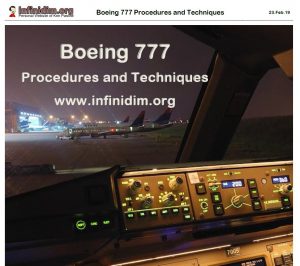For the last decade or so, I have been working on a document called Boeing 777 Procedures and Techniques. It has it’s genesis in what was originally a Common Errors document based on observations of Pilot/Student actions in the Simulator – but most particularly Instructor/Examiner activity in the Brief/Sim/Debrief as well.
See the Feb 2021 update of the document for the latest version.
I recently completed an update of the document, and two versions of it can be accessed as follows:
- Clean Document : Infinidim B777 Procedures and Techniques 23Feb20.PDF
- Highlighted Changes : Infinidim B777 Procedures and Techniques 23Feb20 HL.PDF
Note that the version with Highlighted Changes is only required if you just want to check out what has changed (significantly) since the last version.
 Over the years this document has grown. It’s morphed from a document that purely adds to what Boeing say in the FCOM/FCTM (and elsewhere); to a document that explains what Boeing (likely) intend in the FCOM/FCTM, and how that works in the Simulator and in the Aircraft during Airline Operations. It details and explains Procedures; describes Techniques – but more than this it seeks to raise levels of understanding about why we do certain things the way do – or do not do certain things.
Over the years this document has grown. It’s morphed from a document that purely adds to what Boeing say in the FCOM/FCTM (and elsewhere); to a document that explains what Boeing (likely) intend in the FCOM/FCTM, and how that works in the Simulator and in the Aircraft during Airline Operations. It details and explains Procedures; describes Techniques – but more than this it seeks to raise levels of understanding about why we do certain things the way do – or do not do certain things.
While I wrote it for my Airline, our Instructors, our Pilots – much of the content is universally relevant to all 777 operations – and wider. I’ve been fascinated where it’s turned up. At one point I needed some kind of simulation software on my PC to make training material. I discovered PMDG’s excellent B777-200/300 product and Rockwell Collins excellent Prepar3D. While wandering around the PMDG B777 forum I was fascinated to discover that most of the avid B777 simmers were referring to a 2011 copy of Procedures and Techniques when trying to add real-airline realism to their hobby.
Meanwhile I’ve seen the content popup in several Middle Eastern and Asian 777 carriers, as well as a certain Australian 787 operator …
I’ve spent the past several weeks combing through, reviewing the content and removing identifying references to my own (or any) airline. That said – the essence of this document is my voice to our pilots and instructors, so I hope you find the content speaks to you as well.
I’m always looking for topics of interest to research and write about – the section of on Cold Temperatures Corrections came after a particularly interesting query from Air France. So if you have any suggestions for content, please get in contact.
Ken.
If you find my content useful and are in a position to do so – I would appreciate a contribution to my PayPal account (ken.pascoe@gmail.com) – If you use the Friends and Family feature in PayPal it reduces the charges to the transfer. Please note that when sending money in this way you are removing any form of purchase protection, which is not relevant to a contribution of this type anyway.
